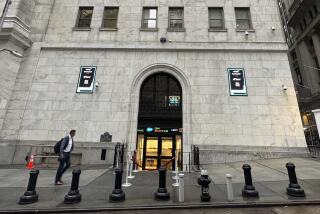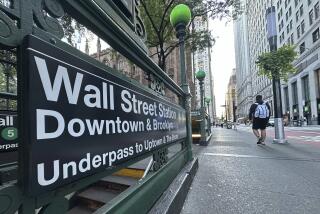STOCKS : Profit Takers Foiled; Dow Up 7.83
Blue chip stocks climbed to a record high for the second straight session Monday, as Wall Street beat back a bout of selling pressure from profit takers.
Buoyed by hopes that the economy will soon emerge from recession, the Dow Jones industrial average closed up 7.83 points at 3,035.33. It was the sixth straight daily advance for the index.
Big Board volume came to 173.99 million shares, down from 232.05 million on Friday.
The Dow had fallen from Friday’s close earlier in the session as investors tried to cash in on the market’s recent gains. But the profit taking failed to stop the Dow’s overall climb.
“We didn’t see the enthusiasm on the selloff during the day that we had in the buying on Thursday and Friday,” said Robert Stovall of Stovall/21st Advisers. “The market handled itself well all day.”
Analysts said industrial cyclical stocks--those tied to the health of the economy--put in another strong performance. But other sectors languished.
In the broader market, advancing issues slightly outnumbered declines in nationwide trading of New York Stock Exchange-listed stocks, with 808 issues rising, 750 declining and 508 unchanged.
Investors got more signs that the economy is heading out of recession. Spending on new construction projects posted its strongest gain during April in 14 months.
And in the first clue of the state of the economy during May, the National Assn. of Purchasing Management said its monthly index climbed to 45.4% last month from 42.1% in April.
The index measures the buying plans of a wide range of purchasing managers and is regarded by economists as a good signal of the economy’s direction. In general, any figure below 44% shows the economy is in recession.
Among the market highlights:
* Industrial stock leaders included Dow Chemical, up 1 1/4 to 56 3/4; Caterpillar, up 1 3/4 to 53 1/2; machinery maker Ingersoll Rand, up 1 3/4 to 53 3/4; industrial parts distributor W.W. Grainger, up 2 3/8 to 91 1/2, and International Paper, up 1 5/8 to 72 1/4.
Investors also chased after various basic metals companies, including Maxxam, up 2 3/4 to 49 3/4; Amax, up 1/2 to 25 3/8, and Quanex, up 5/8 to 16 3/8.
Also, Westinghouse gained 5/8 to 30 3/8, and Emerson Electric rose 3/8 to 50 1/8. Smith Barney repeated “buy” ratings on both stocks.
* Some media stocks advanced, as investors bet that a pickup in the economy will lead to more ad spending. Cap Cities/ABC jumped 13 3/4 to 466 3/4, Washington Post rose 7 to 220 and Knight-Ridder was up 3/4 to 57.
* As they bought industrial stocks, investors cashed out of many of the “safe” growth stocks they’ve held through the recession or longer. Drug stocks were hardest hit. Syntex fell 1 1/8 to 39 1/4, Johnson & Johnson lost 2 1/4 to 88 3/8, Pfizer dropped 2 1/2 to 56 3/8, Merck slipped 2 1/8 to 116 1/8, and Warner-Lambert declined 1 7/8 to 69 5/8.
* Food stocks also fell. Philip Morris dropped 1 1/2 to 66 7/8, Pepsico lost 1/2 to 30 7/8, and Kellogg tumbled 1 3/8 to 97.
* MCI Communications lost 1 3/8 to 30 1/8. Goldman Sachs cut its rating and earnings estimates for the firm.
* Southland issues rising strongly included Jacobs Engineering, up 1 3/4 to 24 3/4; Diagnostic Products, up 1 3/8 to 40 1/4, and Ashton-Tate, up 1 to 10 7/8. Also, Beverly Hills-based bank City National jumped 1 5/8 to 15. Some traders said short sellers who had bet on a falling stock price were covering their positions.
In overseas trading, the Frankfurt market lost ground, with the DAX index easing 10 to 1,694.11.
In London, a robust performance by the drug sector helped shares finish higher. The Financial Times 100-share average ended 16.3 points higher at 2,515.8.
In Tokyo, stocks finished higher on last-minute arbitrage buying. The Nikkei average rose 122.99 to 25,912.61.
In Mexico City, the Bolsa index rocketed 26.40 points or 2.4% to a new all-time high of 1,122.57.
Credit
Fresh signs of an improving economy sent government bond prices sharply lower as analysts gave up hope of new interest rate cuts by the Federal Reserve.
The Treasury’s 30-year bond fell 7/8 point, or $8.75 per $1,000 in face amount. Its yield jumped to 8.34% from 8.26% late Friday.
Bond prices generally fall on news of a growing economy because bonds are considered safe, long-term investments, as opposed to ones that can be more attractive during healthy economic times, such as stocks.
Also, signs of an improving economy indicate that the Federal Reserve will be less inclined to cut interest rates further.
The federal funds rate, the interest on overnight loans between banks, was quoted at 5.875%, down from 6% late Friday.
Currency
The dollar moved moderately higher on expectations that U.S. interest rates would remain firm amid signs that the economy is recovering.
In New York, the U.S. currency ended at 1.748 German marks, up from 1.743 Friday. It rose to 139.15 Japanese yen from 138.30.
Kevin Logan, chief economist for Swiss Bank Corp. in New York, said traders reacted to the government’s report Friday that its chief economic forecasting gauge, the index of leading economic indicators, rose 0.6% in April and to surveys of corporate purchasing executives signaling an improvement in the manufacturing sector.
Commodities
Cotton futures fell sharply after a weekend of favorable crop weather eased some of the supply worries that drove the market to a 10-year high last month.
On other commodity markets, grain and soybean futures rose; precious metals were stronger; oil futures were mixed, and livestock and meat futures were mixed.
Cotton futures settled 1.08 to 1.72 cents lower, with the contract for delivery in July at 84.50 cents a pound.
The July contract has fallen nearly 10 cents a pound since reaching 94.45 cents on May 21.
In less than two weeks, the near-panic over new-crop supply potential has given way to acceptance that the bulk of the Mississippi Delta crop will reach the market later than usual because of wet-weather planting delays.
Elsewhere, gold futures finished $1.60 to $1.80 higher on New York’s Comex, with June at $363 an ounce; silver was 5.8 to 6.6 cents higher, with July at $4.18.
The oil market, meanwhile, seemed spooked by uncertainty a day before OPEC’s summer meeting. Crude oil settled unchanged to 12 cents lower, with July at $21.13 a barrel on the New York Merc.
Market Roundup, D9
More to Read
Inside the business of entertainment
The Wide Shot brings you news, analysis and insights on everything from streaming wars to production — and what it all means for the future.
You may occasionally receive promotional content from the Los Angeles Times.










